European Markets for Cultured Meat: A Comparison of Germany and France
Abstract
1. Introduction
1.1. Meat in Europe
1.2. Cultured Meat
- What proportion of the German and French populations eat conventional meat?
- What are the overall rates of cultured meat acceptance in Germany and France?
- What differences exist in cultured meat acceptance between Germany and France?
- What demographic factors predict acceptance of cultured meat within Germany and France? What additional information is most effective at increasing cultured meat acceptance?
- Do consumers differ in their willingness to consume GM (genetically modified) vs. non-GM cultured meat?
2. Methods
2.1. Process
2.2. Participants
2.3. Statistical Analyses
3. Results
3.1. Dietary Identities
3.2. Overall Cultured Meat Acceptance
3.3. Country Differences in Cultured Meat Acceptance
3.4. Predictors of Cultured Meat Acceptance
3.5. Increasing Cultured Meat Acceptance
3.6. GM vs. Non-GM Cultured Meat
4. Discussion
Supplementary Materials
Author Contributions
Funding
Conflicts of Interest
References
- Poore, J.; Nemecek, T. Reducing food’s environmental impacts through producers and consumers. Science 2018, 360, 987–992. [Google Scholar] [CrossRef] [PubMed]
- Scarborough, P.; Appleby, P.N.; Mizdrak, A.; Briggs, A.D.; Travis, R.C.; Bradbury, K.E.; Key, T.J. Dietary greenhouse gas emissions of meat-eaters, fish-eaters, vegetarians and vegans in the UK. Clim. Chang. 2014, 125, 179–192. [Google Scholar] [CrossRef] [PubMed]
- Leip, A.; Billen, G.; Garnier, J.; Grizzetti, B.; Lassaletta, L.; Reis, S.; Simpson, D.; A Sutton, M.; De Vries, W.; Weiss, F.; et al. Impacts of European livestock production: Nitrogen, sulphur, phosphorus and greenhouse gas emissions, land-use, water eutrophication and biodiversity. Environ. Res. Lett. 2015, 10, 115004. [Google Scholar] [CrossRef]
- Jones, K.E.; Patel, N.G.; Levy, M.A.; Storeygard, A.; Balk, D.; Gittleman, J.L.; Daszak, P. Global trends in emerging infectious diseases. Nature 2008, 451, 990–993. [Google Scholar] [CrossRef] [PubMed]
- Mathew, A.G.; Cissell, R.; Liamthong, S. Antibiotic resistance in bacteria associated with food animals: A United States perspective of livestock production. Foodborne Pathog. Dis. 2007, 4, 115–133. [Google Scholar] [CrossRef]
- Oliver, S.P.; Murinda, S.E.; Jayarao, B.M. Impact of antibiotic use in adult dairy cows on antimicrobial resistance of veterinary and human pathogens: A comprehensive review. Foodborne Pathog. Dis. 2011, 8, 337–355. [Google Scholar] [CrossRef]
- Recanati, F.; Allievi, F.; Scaccabarozzi, G.; Espinosa, T.; Dotelli, G.; Saini, M. Global meat consumption trends and local deforestation in Madre de Dios: Assessing land use changes and other environmental impacts. Procedia Eng. 2015, 118, 630–638. [Google Scholar] [CrossRef]
- IPCC. Global Warming of 1.5 °C: An. IPCC Special Report on the Impacts of Global Warming of 1.5 °C above Pre-Industrial Levels and Related Global Greenhouse Gas. Emission Pathways, in the Context of Strengthening the Global Response to the Threat of Climate Change, Sustainable Development, and Efforts to Eradicate Poverty; Intergovernmental Panel on Climate Change: Geneva, Switzerland, 2018. [Google Scholar]
- Willett, W.; Rockström, J.; Loken, B.; Springmann, M.; Lang, T.; Vermeulen, S.; Jonell, M. Food in the Anthropocene: The EAT–Lancet Commission on healthy diets from sustainable food systems. Lancet 2019, 393, 447–492. [Google Scholar] [CrossRef]
- Bryant, C.J. We Can’t Keep Meating Like This: Attitudes towards Vegetarian and Vegan Diets in the United Kingdom. Sustainability 2019, 11, 6844. [Google Scholar] [CrossRef]
- OECD/FAO. Agricultural Outlook 2018–2027. Chapter 6: Meat. 2018. Available online: http://www.fao.org/3/i9166e/i9166e_Chapter6_Meat.pdf (accessed on 8 August 2020).
- Statista. Per Capita Consumption of Meat Worldwide from 2016 to 2018, With a Forecast for 2028, by Region. 2019. Available online: https://www.statista.com/statistics/1037429/per-capita-consumption-of-meat-worldwide-by-region/ (accessed on 8 August 2020).
- Statista. Per Capita Consumption of Meat in Germany from 1991 to 2019. 2020. Available online: https://www.statista.com/statistics/525324/meat-per-capita-consumption-germany/ (accessed on 8 August 2020).
- Statista. Evolution of the Average Meat Consumption Frequency Per Week in France between 2007 and 2016. 2018. Available online: https://www.statista.com/statistics/938458/meat-consumption-frequency-weekly-france/ (accessed on 8 August 2020).
- Potts, A. What is Meat Culture? Available online: https://brill.com/view/book/edcoll/9789004325852/B9789004325852_002.xml (accessed on 8 August 2020).
- Buckwell, A.E.; Harvey, D.R.; Thomson, K.J.; Parton, K.A. The Costs of the Common Agricultural Policy; Routledge: London, UK, 2019. [Google Scholar]
- Darvas, Z.; Wolff, G.B. Rethinking the European Union’s Post-Brexit Budget Priorities; Bruegel Policy Brief: Brussels, Belgium, 2018. [Google Scholar]
- Garzon, I. Reforming the Common Agricultural Policy: History of a Paradigm Change; Palgrave MacMillan: London, UK, 2006. [Google Scholar]
- Post, M.J. Cultured meat from stem cells: Challenges and prospects. Meat Sci. 2012, 92, 297–301. [Google Scholar] [CrossRef]
- Tuomisto, H.L. The eco-friendly burger: Could cultured meat improve the environmental sustainability of meat products? EMBO Rep. 2019, 20, 47395. [Google Scholar] [CrossRef] [PubMed]
- Bryant, C.; Barnett, J. Consumer acceptance of cultured meat: A systematic review. Meat Sci. 2018, 143, 8–17. [Google Scholar] [CrossRef] [PubMed]
- Bryant, C.J.; Szejda, K.; Deshpande, V.; Parekh, N.; Tse, B. A survey of consumer perceptions of plant-based and clean meat in the USA, India, and China. Front. Sustain. Food Syst. 2019, 3, 11. [Google Scholar] [CrossRef]
- Wilks, M.C.; Phillips, C.J.C.; Fielding, K.; Hornsey, M.J. Testing potential psychological predictors of attitudes towards culured meat. Appetite 2019, 136, 137–145. [Google Scholar] [CrossRef] [PubMed]
- Surveygoo. Nearly One in Three Consumers Willing to Eat Lab-Grown Meat, According to New Research. 2018. Available online: https://www.datasmoothie.com/@surveygoo/nearly-one-in-three-consumers-willing-to-eat-lab-g/ (accessed on 8 August 2020).
- Mattick, C.S.; Wetmore, J.M.; Allenby, B.R. An Anticipatory Social Assessment of Factory-Grown Meat. IEEE Technol. Soc. Mag. 2015, 34, 56–64. [Google Scholar] [CrossRef]
- Mancini, M.C.; Antonioli, F. Exploring consumers’ attitude towards cultured meat in Italy. Meat Sci. 2019, 150, 101–110. [Google Scholar] [CrossRef]
- Flycatcher. Kweekvlees Cultured Meat. Netherlands. 2013. Available online: http://www.flycatcherpanel.nl/news/item/nwsA1697/media/images/Resultaten_onderzoek_kweekvlees.pdf (accessed on 8 August 2020).
- Rolland, N.C.; Markus, C.R.; Post, M.J. The effect of information content on acceptance of cultured meat in a tasting context. PLoS ONE 2020, 15, e0231176. [Google Scholar] [CrossRef]
- Eurobarometer. Social Values, Science and Technology: European Commission. 2005. Available online: https://ec.europa.eu/commfrontoffice/publicopinion/archives/ebs/ebs_225_report_en.pdf (accessed on 8 August 2020).
- Gómez-Luciano, C.A.; de Aguiar, L.K.; Vriesekoop, F.; Urbano, B. Consumers’ willingness to purchase three alternatives to meat proteins in the United Kingdom, Spain, Brazil and the Dominican Republic. Food Qual. Prefer. 2019, 78, 103732. [Google Scholar] [CrossRef]
- Grasso, A.C.; Hung, Y.; Olthof, M.R.; Verbeke, W.; Brouwer, I.A. Older Consumers’ Readiness to Accept Alternative, More Sustainable Protein Sources in the European Union. Nutrients 2019, 11, 1904. [Google Scholar] [CrossRef]
- Swann, D. The Economics of Europe: From Common Market to European Union; Penguin: London, UK, 2000. [Google Scholar]
- Hocquette, A.; Lambert, C.; Sinquin, C.; Peterolff, L.; Wagner, Z.; Bonny, S.P.; Hocquette, J.F. Educated consumers don’t believe artificial meat is the solution to the problems with the meat industry. J. Integr. Agric. 2015, 14, 273–284. [Google Scholar] [CrossRef]
- Weinrich, R.; Strack, M.; Neugebauer, F. Consumer acceptance of cultured meat in Germany. Meat Sci. 2020, 162, 107924. [Google Scholar] [CrossRef] [PubMed]
- Dupont, J.; Fiebelkorn, F. Attitudes and acceptance of young people toward the consumption of insects and cultured meat in Germany. Food Qual. Prefer. 2020, 103983. [Google Scholar] [CrossRef]
- ESOMAR. ESOMAR Guideline for Online Research. 2011. Available online: https://www.esomar.org/uploads/public/knowledge-and-standards/codes-and-guidelines/ESOMAR_Guideline-for-online-research.pdf (accessed on 8 August 2020).
- Curtin, F.; Schulz, P. Multiple correlations and Bonferroni’s correction. Biol. Psychiatry 1998, 44, 775–777. [Google Scholar] [CrossRef]
- Shaw, E.; Mac Con Iomaire, M. A comparative analysis of the attitudes of rural and urban consumers towards cultured meat. Br. Food J. 2019, 121, 1782–1800. [Google Scholar] [CrossRef]
- Slade, P. If you build it, will they eat it? Consumer preferences for plant-based and cultured meat burgers. Appetite 2018, 125, 428–437. [Google Scholar] [CrossRef]
- Wilks, M.; Phillips, C.J. Attitudes to in vitro meat: A survey of potential consumers in the United States. PLoS ONE 2017, 12, e0171904. [Google Scholar] [CrossRef]
- Statista. Share of Young Adults Who Are Vegetarian or Vegan in Selected European Countries in 2017. 2017. Available online: https://www.statista.com/statistics/768475/vegetarianism-and-veganism-among-young-adults-in-selected-european-countries/ (accessed on 8 August 2020).
- Piazza, J.; Ruby, M.B.; Loughnan, S.; Luong, M.; Kulik, J.; Watkins, H.M.; Seigerman, M. Rationalizing meat consumption. The 4Ns. Appetite 2015, 91, 114–128. [Google Scholar] [CrossRef]
- Eating Better. Public Attitudes to Meat Consumption. 2019. Available online: https://www.eating-better.org/blog/attitudes-to-meat-consumption (accessed on 8 August 2020).
- Verbeke, W.; Marcu, A.; Rutsaert, P.; Gaspar, R.; Seibt, B.; Fletcher, D.; Barnett, J. ‘Would you eat cultured meat?’: Consumers’ reactions and attitude formation in Belgium, Portugal and the United Kingdom. Meat Sci. 2015, 102, 49–58. [Google Scholar] [CrossRef]
- Coghlan, A. More than Half of EU Officially Bans Genetically Modified Crops. Available online: https://www.newscientist.com/article/dn28283-more-than-half-of-european-union-votes-to-ban-growing-gm-crops/ (accessed on 8 August 2020).
- Mohorčich, J.; Reese, J. Cell-cultured meat: Lessons from GMO adoption and resistance. Appetite 2019, 143, 104408. [Google Scholar] [CrossRef]
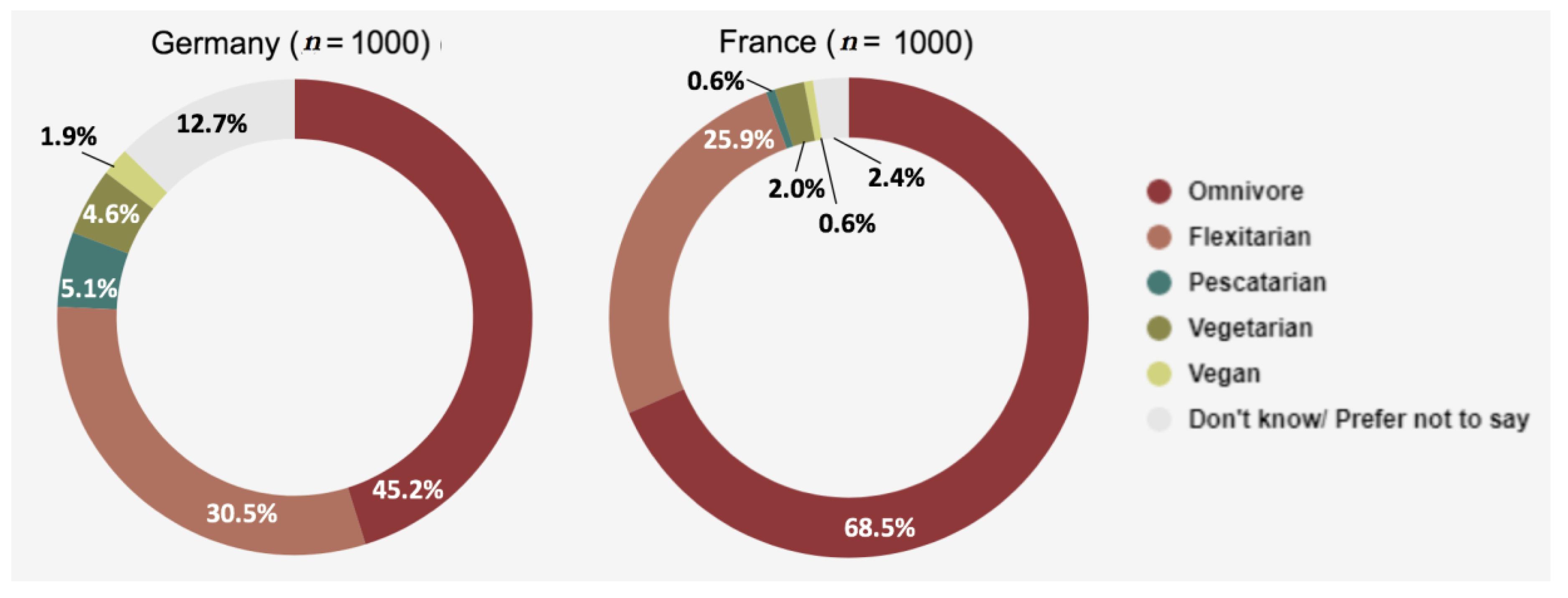
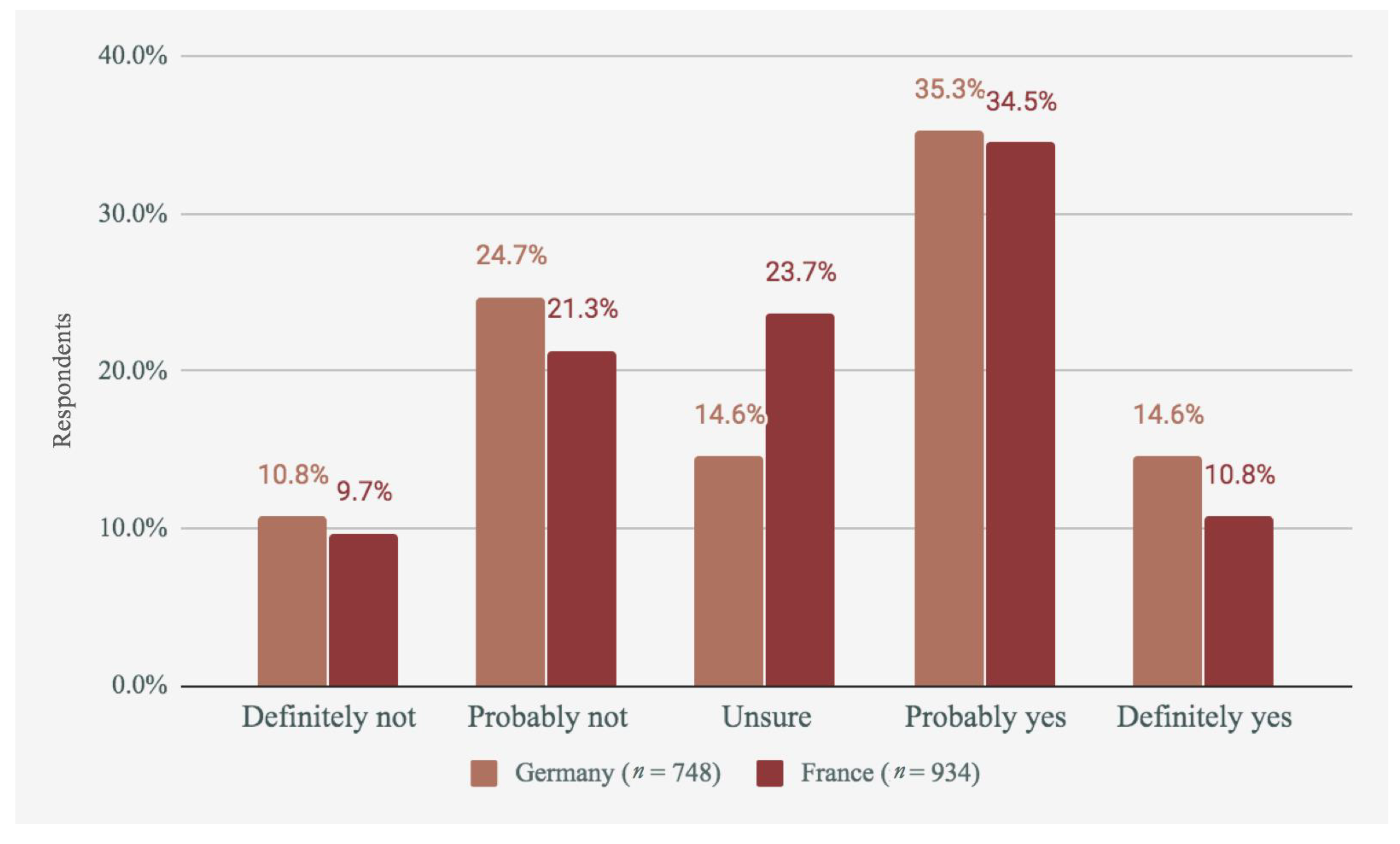
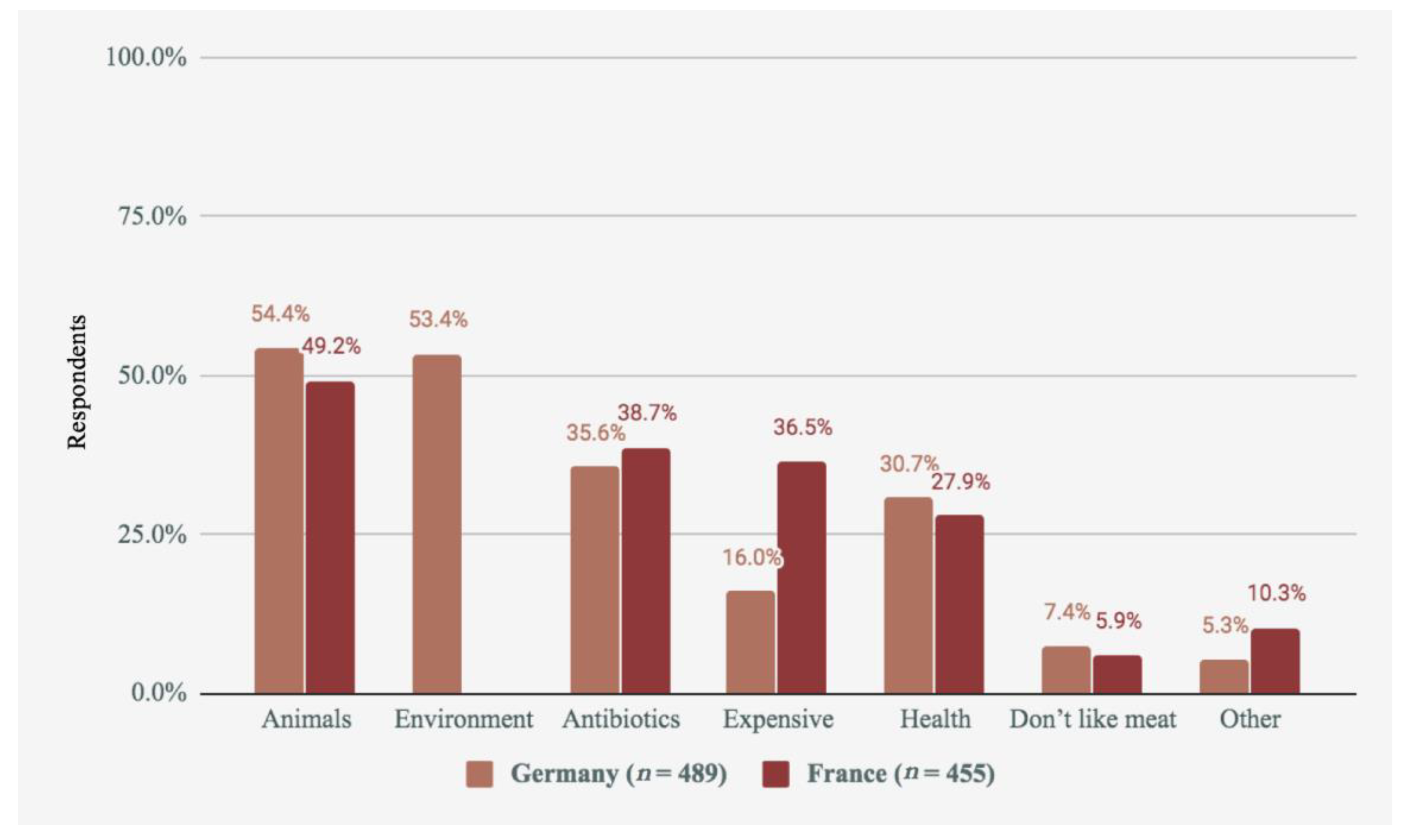
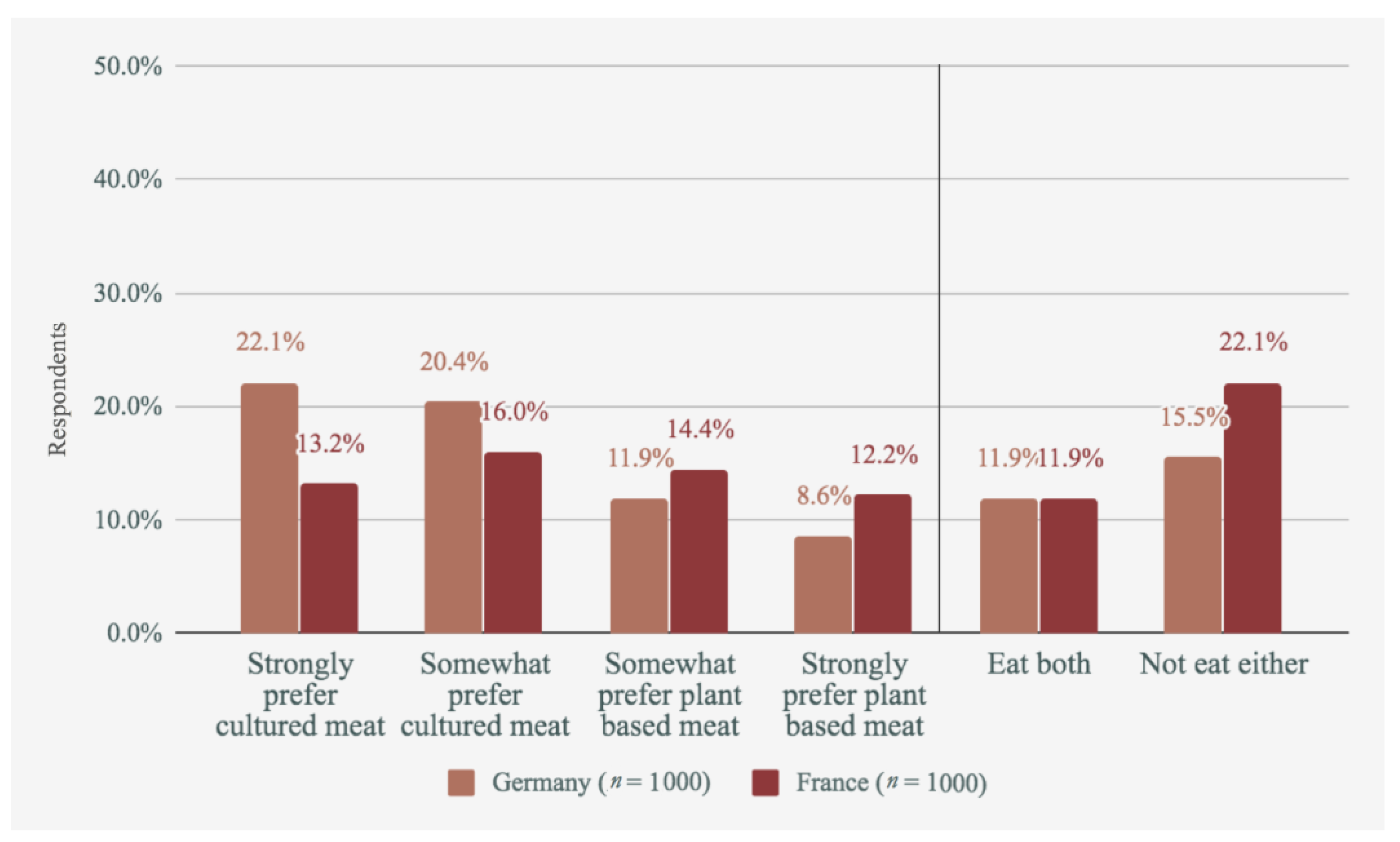
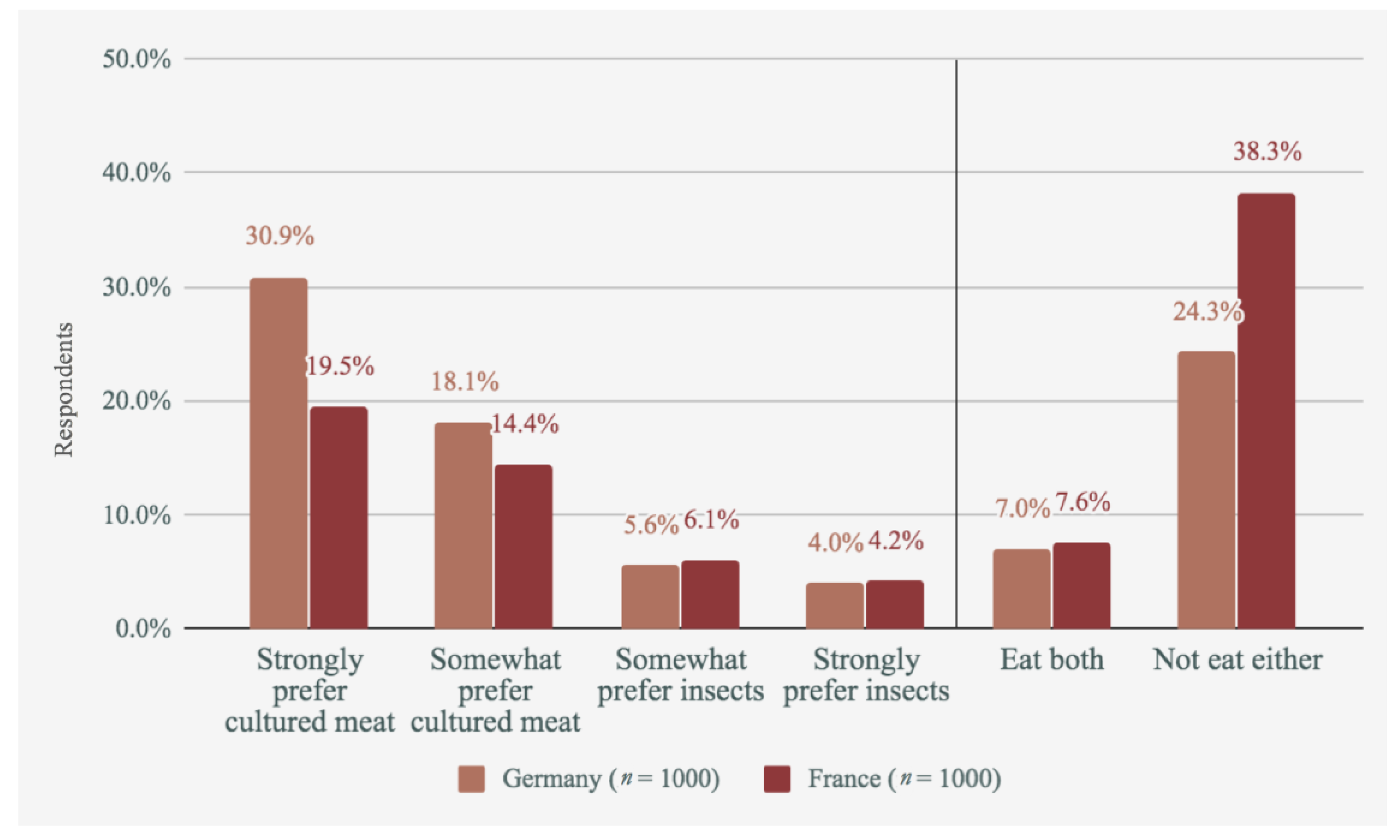
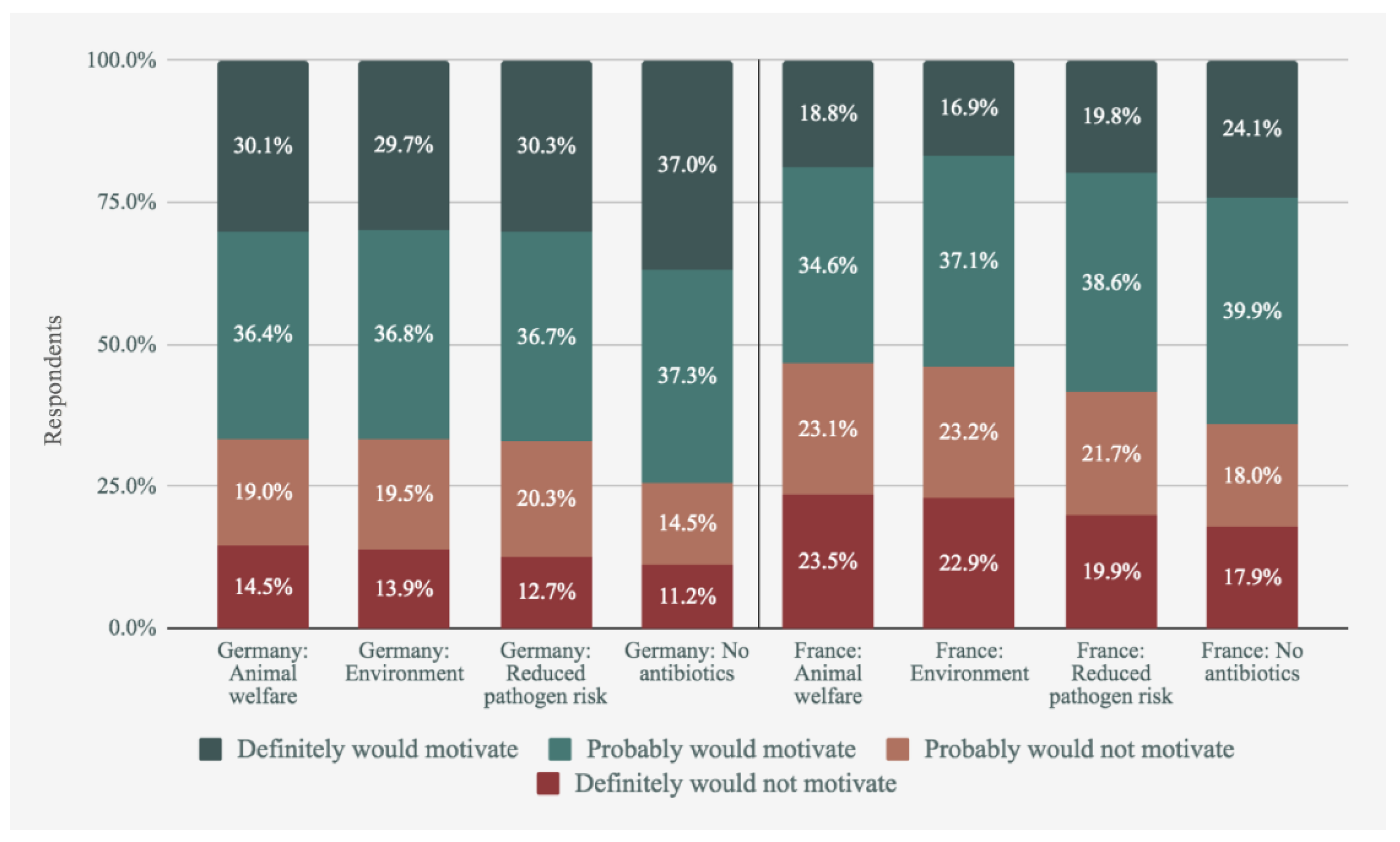
| France (n = 1000) | Germany (n = 1000) | ||
|---|---|---|---|
| Gender | Male | 47.4% | 49.2% |
| Female | 52.6% | 50.8% | |
| Age | 18–34 | 34.0% | 33.0% |
| 35–54 | 45.0% | 45.0% | |
| 55–65 | 21.0% | 22.0% |
| Germany | France | |||||
|---|---|---|---|---|---|---|
| Yes | Maybe | No | Yes | Maybe | No | |
| Heard of cultured meat * | 22.6% | 21.9% | 55.5% | 16.0% | 21.6% | 62.4% |
| In favour of cultured meat | 32.6% | 39.7% | 27.7% | 20.1% | 30.8% | 49.1% |
| Would try cultured meat | 58.3% | 8.1% | 33.6% | 44.2% | 9.8% | 46.1% |
| Would buy cultured meat | 55.7% | 12.4% | 31.9% | 36.8% | 13.8% | 49.4% |
| Would replace conventional meat (meat-eaters only) | 53.1% | 12.8% | 34.1% | 34.2% | 12.9% | 52.8% |
| Measure | Germany Mean (SD) | France Mean (SD) | T-test |
|---|---|---|---|
| Familiarity | 1.67 (0.82) | 1.54 (0.76) | t = 3.676, p < 0.001 * |
| In favour | 3.02 (1.21) | 2.41 (1.24) | t = 10.788, p < 0.001 * |
| Willing to try | 2.71 (0.97) | 2.33 (1.02) | t = 7.984, p < 0.001 * |
| Willing to buy | 2.67 (0.97) | 2.25 (1.01) | t = 8.905, p < 0.001 * |
| Replace | 2.61 (1.01) | 2.15 (1.00) | t = 8.796, p < 0.001 * |
| Germany | France | |||
|---|---|---|---|---|
| R2 = 0.045, Adj R2 = 0.031 F (8550) = 3.245, p = 0.001 | R2 = 0.068, Adj R2 = 0.056 F (8592) = 5.424, p < 0.001 | |||
| Standardised β | p | Standardised β | p | |
| (Constant) | 3.564 | 2.924 | ||
| Frequency of meat consumption | −0.006 | 0.893 | 0.078 | 0.079 |
| Gender (female) | −0.024 | 0.590 | −0.094 * | 0.021 |
| Age group | −0.135 * | 0.002 | −0.167 * | <0.001 |
| Urbanness | −0.016 | 0.710 | 0.086 * | 0.033 |
| Agricultural worker | 0.081 | 0.070 | 0.100 * | 0.014 |
| Political views | −0.056 | 0.196 | −0.025 | 0.546 |
| Income group | −0.048 | 0.266 | −0.018 | 0.653 |
| Diet | 0.072 | 0.115 | −0.021 | 0.643 |
| Environment | Animals | Food Safety | Antibiotics | |
|---|---|---|---|---|
| Mean (SD) | 2.65 (1.04)a | 2.64 (1.05)a | 2.71 (1.02)b | 2.84 (1.02)c |
| Comparisons (t tests) | ||||
| Environment | - | - | - | - |
| Animals | t = 0.00, p = 1.00 | - | - | - |
| Food Safety | t = 3.94, p < 0.01 * | t = 4.35, p < 0.01 * | - | - |
| Antibiotics | t = 11.55, p < 0.01 * | t = 11.36, p < 0.01 * | t = 9.04, p < 0.01 * | - |
| Non-GM Mean (SD) | GM Mean (SD) | t | p | |
|---|---|---|---|---|
| Germany * | 3.22 (0.58) | 2.46 (0.91) | −14.255 | <0.001 |
| France * | 3.19 (0.60) | 1.94 (0.94) | −19.292 | <0.001 |
© 2020 by the authors. Licensee MDPI, Basel, Switzerland. This article is an open access article distributed under the terms and conditions of the Creative Commons Attribution (CC BY) license (http://creativecommons.org/licenses/by/4.0/).
Share and Cite
Bryant, C.; van Nek, L.; Rolland, N.C.M. European Markets for Cultured Meat: A Comparison of Germany and France. Foods 2020, 9, 1152. https://doi.org/10.3390/foods9091152
Bryant C, van Nek L, Rolland NCM. European Markets for Cultured Meat: A Comparison of Germany and France. Foods. 2020; 9(9):1152. https://doi.org/10.3390/foods9091152
Chicago/Turabian StyleBryant, Christopher, Lea van Nek, and Nathalie C. M. Rolland. 2020. "European Markets for Cultured Meat: A Comparison of Germany and France" Foods 9, no. 9: 1152. https://doi.org/10.3390/foods9091152
APA StyleBryant, C., van Nek, L., & Rolland, N. C. M. (2020). European Markets for Cultured Meat: A Comparison of Germany and France. Foods, 9(9), 1152. https://doi.org/10.3390/foods9091152







